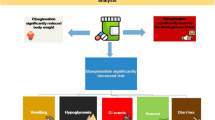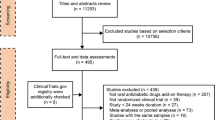Abstract
Clinicians and patients with type 2 diabetes enjoy an expanding list of medications to improve glycemic control. With this expansion has come a flurry of concerns about the safety of these antihyperglycemic agents, concerns that affect judgments about the risk/benefit balance of therapy. Some of these safety signals have been identified through the synthesis of existing research evidence. Thus, it has become important for clinicians and clinical policymakers to understand the strengths and limitations of systematic reviews and meta-analyses in determining the safety of diabetes medications. In this paper, we highlight key safety concerns with diabetes medications and discuss the role evidence synthesis plays in each, with special attention to its strengths and limitations.

Similar content being viewed by others
References
Papers of particular interest, published recently, have been highlighted as: • Of importance •• Of major importance
Centers for Disease Control and Prevention. Increasing prevalence of diagnosed diabetes—United States and Puerto Rico, 1995–2010. Morb Mortal Wkly Rep. 2012;61:918–21.
Salpeter SR, Greyber E, Pasternak GA, Salpeter EE. Risk of fatal and nonfatal lactic acidosis with metformin use in type 2 diabetes mellitus. Cochrane Database Syst Rev. 2010;4, CD002967. doi:10.1002/14651858.CD002967.pub4.
Silagy CA, Middleton P, Hopewell S. Publishing protocols of systematic reviews: comparing what was done to what was planned. JAMA. 2002;287:2831–4.
Green S, Higgins JPT, Alderson P, Clarke M, Mulrow CD, Oxman AD. Chapter 1: Introduction. In: Higgins JPT, Green S (editors), Cochrane Handbook for Systematic Reviews of Interventions Version 5.1.0 (updated March 2011). The Cochrane Collaboration, 2011. Available from http://www.cochrane-handbook.org.
Lavis JN. How can we support the use of systematic reviews in policymaking? PLoS Med. 2009;6:e1000141. doi:10.1371/journal.pmed.1000141.
Nissen SE, Wolski K, Topol EJ. Effect of muraglitazar on death and major adverse cardiovascular events in patients with type 2 diabetes mellitus. JAMA. 2005;294:2581–6. doi:10.1001/jama.294.20.joc50147.
Mehta SN, Goldfine AB, Abrahamson MJ, DiVincenzo R, Laffel LM. Changing prescribing patterns of type 2 diabetes medications from 2002–2010: an electronic health record-based evaluation. J Diabetes Sci Technol. 2013;7:119–22.
Psaty BM, Furberg CD. Rosiglitazone and cardiovascular risk. N Engl J Med. 2007;356:2522–4. doi:10.1056/NEJMe078099.
Nissen SE, Wolski K. Effect of rosiglitazone on the risk of myocardial infarction and death from cardiovascular causes. N Engl J Med. 2007;356:2457–71. doi:10.1056/NEJMoa072761.
Singh S, Loke YK, Furberg CD. Long-term risk of cardiovascular events with rosiglitazone: a meta-analysis. JAMA. 2007;298:1189–95. doi:10.1001/jama.298.10.1189.
Hiatt WR, Kaul S, Smith RJ. The cardiovascular safety of diabetes drugs—insights from the rosiglitazone experience. N Engl J Med. 2014;369:1285–7. doi:10.1056/NEJMp1309610.
•Nissen SE, Wolski K. Rosiglitazone revisited: an updated meta-analysis of risk for myocardial infarction and cardiovascular mortality. Arch Intern Med. 2010;170:1191–201. doi:10.1001/archinternmed.2010.207. This meta-analysis included the largest trial of cardiovascular safety for rosiglitazone and confirmed an increased of myocardial infarction and heart failure associated with rosiglitazone use.
•Home PD, Pocock SJ, Beck-Nielsen H, Curtis PS, Gomis R, Hanefeld M, et al. Rosiglitazone evaluated for cardiovascular outcomes in oral agent combination therapy for type 2 diabetes (RECORD): a multicenter, randomized, open-label trial. Lancet. 2009;373:2125–35. doi:10.1016/s0140-6736(09)60953-3. This is the largest randomized trial looking at the cardiovascular safety of rosiglitazone and is at the center of the controversy surrounding the cardiovascular safety of rosiglitazone.
Egger M, Smith GD, Altman D. Systematic reviews in health care: meta-analysis in context. London: BMJ books; 2008.
Balshem H, Helfand M, Schunemann HJ, Oxman AD, Kunz R, Brozek J, et al. GRADE guidelines: 3. Rating the quality of evidence. J Clin Epidemiol. 2011;64:401–6. doi:10.1016/j.jclinepi.2010.07.015.
••Department of Health and Human Services. Advisory committee meeting for NDA 21071 Avandia (rosiglitazone maleate) tablet July 13 and 14, 2010. http://www.fda.gov/AdvisoryCommittees/CommitteesMeetingMaterials/Drugs/EndocrinologicandMetabolicDrugsAdvisoryCommittee/ucm218491.htm. This document details the 2010 FDA review of rosiglitazone, within which the limitations of the RECORD trial are highlighted.
Food and Drug Administration. FDA requires removal of certain restrictions on the diabetes drug Avandia. November 25, 2013. http://www.fda.gov/NewsEvents/Newsroom/PressAnnouncements/ucm376516.htm.
Ioannidis JP, Trikalinos TA. Early extreme contradictory estimates may appear in published research: the Proteus phenomenon in molecular genetics research and randomized trials. J Clin Epidemiol. 2005;58:543–9. doi:10.1016/j.jclinepi.2004.10.019.
Ioannidis JP. Evolution and translation of research findings: from bench to where? PLoS Clin Trials. 2006;1:e36. doi:10.1371/journal.pctr.0010036.
•Murad M, Montori VM. Synthesizing evidence: shifting the focus from individual studies to the body of evidence. JAMA. 2013;309:2217–8. doi:10.1001/jama.2013.5616. This paper expounds the reasons why clinicians should examine the body of evidence rather than individuals studies.
Lincoff AM, Wolski K, Nicholls SJ, Nissen SE. Pioglitazone and risk of cardiovascular events in patients with type 2 diabetes mellitus: a meta-analysis of randomized trials. JAMA. 2007;298:1180–8. doi:10.1001/jama.298.10.1180.
Kahn SE, Haffner SM, Heise MA, Herman WH, Holman RR, Jones NP, et al. Glycemic durability of rosiglitazone, metformin, or glyburide monotherapy. N Engl J Med. 2006;355:2427–43. doi:10.1056/NEJMoa066224.
Loke YK, Singh S, Furberg CD. Long-term use of thiazolidinediones and fractures in type 2 diabetes: a meta-analysis. CMAJ. 2009;180:32–9. doi:10.1503/cmaj.080486.
Felson DT. Bias in meta-analytic research. J Clin Epidemiol. 1992;45:885–92.
Savoie I, Helmer D, Green CJ, Kazanjian A. Beyond Medline: reducing bias through extended systematic review search. Int J Technol Assess Health Care. 2003;19:168–78.
Sampson M, McGowan J. Errors in search strategies were identified by type and frequency. J Clin Epidemiol. 2006;59:1057–63. doi:10.1016/j.jclinepi.2006.01.007.
Dormandy JA, Charbonnel B, Eckland DJ, Erdmann E, Massi-Benedetti M, Moules IK, et al. Secondary prevention of macrovascular events in patients with type 2 diabetes in the PROactive Study (PROspective pioglitAzone Clinical Trial In macroVascular Events): a randomized controlled trial. Lancet. 2005;366:1279–89. doi:10.1016/s0140-6736(05)67528-9.
Lewis JD, Ferrara A, Peng T, Hedderson M, Bilker WB, Quesenberry Jr CP, et al. Risk of bladder cancer among diabetic patients treated with pioglitazone: interim report of a longitudinal cohort study. Diabetes Care. 2011;34:916–22. doi:10.2337/dc10-1068.
Piccinni C, Motola D, Marchesini G, Poluzzi E. Assessing the association of pioglitazone use and bladder cancer through drug adverse event reporting. Diabetes Care. 2011;34:1369–71. doi:10.2337/dc10-2412.
Colmers IN, Bowker SL, Majumdar SR, Johnson JA. Use of thiazolidinediones and the risk of bladder cancer among people with type 2 diabetes: a meta-analysis. CMAJ. 2012;184:E675–83. doi:10.1503/cmaj.112102.
Ferwana M, Firwana B, Hasan R, Al-Mallah MH, Kim S, Montori VM, et al. Pioglitazone and risk of bladder cancer: a meta-analysis of controlled studies. Diabetes Med. 2013;30:1026–32. doi:10.1111/dme.12144.
Singh S, Chang HY, Richards TM, Weiner JP, Clark JM, Segal JB. Glucagonlike peptide 1-based therapies and risk of hospitalization for acute pancreatitis in type 2 diabetes mellitus: a population-based matched case-control study. JAMA Intern Med. 2013;173:534–9. doi:10.1001/jamainternmed.2013.2720.
Elashoff M, Matveyenko AV, Gier B, Elashoff R, Butler PC. Pancreatitis, pancreatic, and thyroid cancer with glucagon-like peptide-1-based therapies. Gastroenterology. 2011;141:150–6. doi:10.1053/j.gastro.2011.02.018.
Monami M, Dicembrini I, Mannucci E. Dipeptidyl peptidase-4 inhibitors and pancreatitis risk: a meta-analysis of randomized clinical trials. Diabetes Obes Metab. 2013;16:48–56. doi:10.1111/dom.12176.
••Cohen D. Has pancreatic damage from glucagon suppressing diabetes drugs been underplayed? BMJ. 2013;346:f3680. doi:10.1136/bmj.f3680. This is an investigative report written by an editor from the BMJ that highlights the concerns around the safety of glucagon supressing drugs.
Murad MH, Coto-Yglesias F, Wang AT, Sheidaee N, Mullan RJ, Elamin MB, et al. Clinical review: drug-induced hypoglycemia: a systematic review. J Clin Endocrinol Metab. 2009;94:741–5. doi:10.1210/jc.2008-1416.
Meinert CL. Clinical trials: design, conduct and analysis. New York, New York: Oxford University Press; 2012.
Duijnhoven RG, Straus SM, Raine JM, de Boer A, Hoes AW, De Bruin ML. Number of patients studied prior to approval of new medicines: a database analysis. PLoS Med. 2013;10:e1001407. doi:10.1371/journal.pmed.1001407.
Meinert CL. Clinical Trials Dictionary: Terminology and usage recommendations. Hoboken, NJ: John Wiley & Sons, Inc.; 2012.
U.S. Food and Drug Administration. FDA’s Sentinel Initiative. 2013. http://www.fda.gov/Safety/FDAsSentinelInitiative/default.htm. Accessed 19 Sept 2013.
Heeley E, Riley J, Layton D, Wilton LV, Shakir SAW. Prescription-event monitoring and reporting of adverse drug reactions. Lancet. 2001;358:1872–3. doi:10.1016/S0140-6736(01)06898-2.
Hazell L, Shakir SAW. Under-reporting of adverse drug reactions: a systematic review. Drug Saf. 2006;29:385.
Acknowledgments
This publication was supported by CCaTS Grant Number TL1 TR000137 from the National Center for Advancing Translational Science (NCATS). Its contents are solely the responsibility of the authors and do not necessarily represent the official views of the NIH.
Compliance with Ethics Guidelines
ᅟ
Conflict of Interest
Michael R. Gionfriddo declares that he has no conflict of interest. Oscar L. Morey-Vargas declares that he has no conflict of interest. Juan P. Brito declares that he has no conflict of interest. Aaron L. Leppin declares that he has no conflict of interest. M. Hassan Murad declares that he has no conflict of interest. Victor M. Montori declares that he has no conflict of interest.
Human and Animal Rights and Informed Consent
This article does not contain any studies with human or animal subjects performed by any of the authors.
Author information
Authors and Affiliations
Corresponding author
Additional information
This article is part of the Topical Collection on Pharmacologic Treatment of Type 2 Diabetes
Rights and permissions
About this article
Cite this article
Gionfriddo, M.R., Morey-Vargas, O.L., Brito, J.P. et al. Systematic Reviews to Ascertain the Safety of Diabetes Medications. Curr Diab Rep 14, 478 (2014). https://doi.org/10.1007/s11892-014-0478-0
Published:
DOI: https://doi.org/10.1007/s11892-014-0478-0




